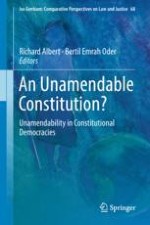2018 | OriginalPaper | Chapter
Conventions of Unamendability: Covert Constitutional Unamendability in (Two) Politically Enforced Constitutions
Authors : Gert Jan Geertjes, Jerfi Uzman
Published in: An Unamendable Constitution?
Publisher: Springer International Publishing
Activate our intelligent search to find suitable subject content or patents.
Select sections of text to find matching patents with Artificial Intelligence. powered by
Select sections of text to find additional relevant content using AI-assisted search. powered by
